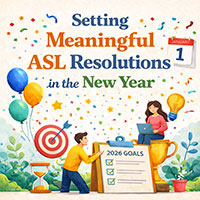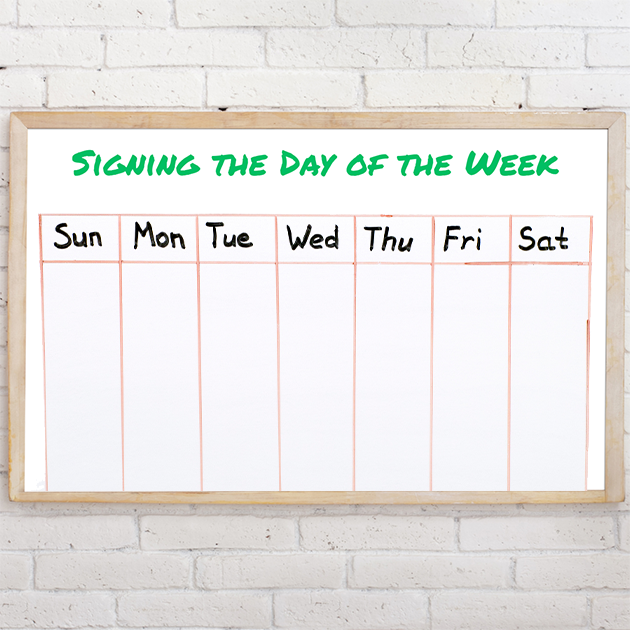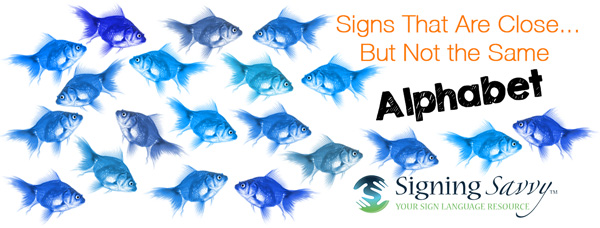
Signs That Are Close... But Not the Same - Alphabet
This article is part of our “Signs That Are Close... But Not the Same” series, which highlights signs that look similar, but have different meanings.
The ASL signs shown below look similar, but are not the same. There are many ASL signs that when produced look similar, but in fact have a completely different meaning. Below you will find examples of such signs. Watch closely to see if you can see the differences. In addition, watch my eyebrows, look to see when I tilt my head or lean my body in a certain way, even what my mouth is doing. These nuances are called inflections and trust me, inflections matter.
These examples are all from the fingerspelling alphabet. As you learn to fingerspell, identifying these little differences is very important.
1. A vs. S vs. T
A, S, and T look similar because they all use a closed fist. The placement of the thumb is the main difference.
- For A, the thumb is on the side of the hand and the other fingers are closed.
- For S, the thumb is on top of the closed fingers.
- For T, the thumb is under the closed index finger. Think of the top line in the letter T as the index finger on top of the thumb to remember the placement of the fingers when forming the letter T.
 |
||
2. A vs. E
A and E look similar because they both look almost like a closed fist, but A has the thumb on the side of the hand, while E starts to lengthen the fist by having the thumb folded in under the raised fingers.
 |
3. E vs. O vs. C
E, O, and C look similar and almost look like a progression from a closed fist to an open hand.
- E has the thumb folded in with the fingers resting on it.
- O has all the fingers outward a little more, forming the shape of an O, with the fingertips of your fingers touching the fingertip of the thumb.
- C has the hand open with a curve in your fingers to form the shape of a C. Remember to face your C with palm forward, just like your O and your E, and not to the side.
 |
||
4. P vs. K
P and K actually use the same handshape - resembling a slanted number 2 (or you may think of it as the shape of the lines you see in a written K) with the thumb tucked up and touching the bottom of the index finger and also resting against the middle finger.
- P has the index finger pointing outward and your palm down.
- K has the index finger pointing upwards and your palm out.
 |
5. 1 vs. D vs. K
1, D, and K all look similar because they are like a fist with the index finger up.
- 1 is a closed fist with the index finger pointed up.
- D has the index finger up and the fingertips of the middle finger and thumb touching with a curved shape, like the curved shape of a written lowercase d.
- K has the index finger up, middle finger pointing out, and the thumb tucked up against the index and middle fingers.
 |
||
6. G vs. H vs. Q vs. U vs. N
G and H look similar because they both have the base of the hand in a fist-like shape with the palm facing the non-dominant side of the body and have some of the top fingers pointing out in that same direction.
- When signing the letter G, the thumb and top finger (the index finder) are pointed out.
- When signing H, the thumb and top two fingers (the index and middle fingers) are pointed out.
- Q also looks similar because it uses the same handshape as G but has the palm and pointing fingers facing down.
- U also looks similar because it uses the same handshape as H but has the palm facing out and fingers pointing up.
- N also looks similar because it uses a similar handshape as H, but the thumb is tucked right under the index and middle fingers and the palm is facing out. It is similar to U, but the thumb is tucked up and the index and middle fingers point out instead of up.
 |
||
7. N vs. M
N and M look similar because they both have the palm facing forward with some fingers pointed outward.
- When signing N, two fingers (the index and middle fingers) are pointed outward, with the thumb bent and tucked under them.
- When signing M, all four fingers (or you may also see it signed using just the first three fingers - the index, middle and ring fingers) are pointed out, with the thumb bent and tucked under them.
 |
8. R vs. U
R and U look similar because they are like a fist with with two fingers pointing up.
- R is a closed fist, with the palm facing forward, and the index and middle fingers crossed while pointing up.
- U is a closed fist, with the palm facing forward, and the index and middle fingers touching each other while pointing up.
 |
9. J vs. Z
J and Z look similar because the hand is in a fist-like shape with one finger pointed out and the sign has movement from the wrist. However, the finger pointing out when signing J is the pinky finger, while it is the index finger when signing Z. The movement is also different, with the pinky finger tracing the shape of a written J when signing the letter J, and the index finger tracing the shape of a written Z when signing the letter Z.
 |
How can I figure out the difference between signs on my own?
If you see two signs that look close, but not the same, and you’re not sure, you may use Signing Savvy features to help you figure out the difference. All of our signs have sign descriptions and memory aids that members may access. Reading the sign description and memory aids for the signs will help you figure out the small differences between them that your eyes don’t catch at first. We also recommend using the pause and slow motion feature to slow down the video, so you may take a closer look. These features are available to Signing Savvy members.
ADVERTISEMENTS
 Brenda Cartwright is a Coda, seasoned interpreter, a master teacher, well known presenter, and author of several best selling sign language and interpreting textbooks from the RID Press. For 35 years Brenda was the Chair of the Sign Language Interpreter Program at Lansing Community College in Lansing, Michigan.
Brenda Cartwright is a Coda, seasoned interpreter, a master teacher, well known presenter, and author of several best selling sign language and interpreting textbooks from the RID Press. For 35 years Brenda was the Chair of the Sign Language Interpreter Program at Lansing Community College in Lansing, Michigan.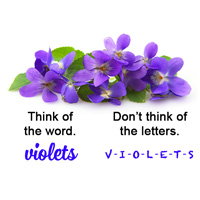 Tips When Starting to Fingerspell
Tips When Starting to Fingerspell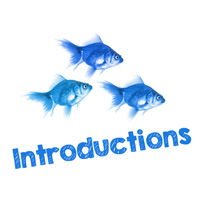 Signs That Are Close... But Not the Same — Introductions
Signs That Are Close... But Not the Same — Introductions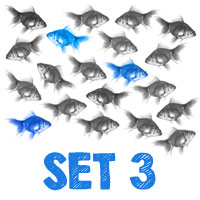 Signs That Are Close... But Not the Same - Set 3
Signs That Are Close... But Not the Same - Set 3

